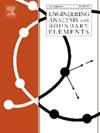The three-dimensional elastoplastic analysis of bi-directional functionally graded materials using a meshfree global radial basis reproducing kernel particle method
IF 4.2
2区 工程技术
Q1 ENGINEERING, MULTIDISCIPLINARY
Engineering Analysis with Boundary Elements
Pub Date : 2025-02-18
DOI:10.1016/j.enganabound.2025.106176
引用次数: 0
Abstract
The meshless global radial basis reproducing kernel particle method (GRB-RKPM), constructed based on the global radial basis function and the reproducing kernel particle method (RKPM), is extended to the investigation of the three-dimensional (3D) elastoplastic problem of bi-directional functional gradient materials (BDFGMs). The discrete equations in the incremental form are established based on the Galerkin integral weak formulation of the 3D elastoplastic problem. The solution equations of the GRB-RKPM for the 3D elastoplastic problem of BDFGMs are derived using the incremental tangent stiffness method. The numerical accuracy, convergence, and stability of the GRB-RKPM are analyzed. BDFGMs based on the exponential and Voigt models are employed in the numerical examples. The numerical results demonstrate that the GRB-RKPM is effective in solving the 3D elastoplastic problem of BDFGMs. The computational accuracy of the GRB-RKPM is higher than that of the GRBF, the RKPM and the local radial basis reproducing kernel particle method. The displacement of the 3D elastoplastic of BDFGMs decreases with an increase in the gradient index.
基于无网格全局径向基再现核粒子法的双向功能梯度材料三维弹塑性分析
将无网格全局径向基再现核粒子法(GRB-RKPM)推广到双向功能梯度材料(BDFGMs)三维弹塑性问题的研究中,该方法是在全局径向基函数和再现核粒子法的基础上建立的。基于三维弹塑性问题的伽辽金积分弱形式,建立了增量形式的离散方程。采用渐进式切线刚度法推导了BDFGMs三维弹塑性问题的GRB-RKPM求解方程。分析了GRB-RKPM的数值精度、收敛性和稳定性。数值算例采用了基于指数模型和Voigt模型的BDFGMs。数值计算结果表明,GRB-RKPM算法对于求解bdfgm的三维弹塑性问题是有效的。GRB-RKPM的计算精度高于GRBF、RKPM和局部径向基再现核粒子法。随着梯度指数的增大,BDFGMs的三维弹塑性位移减小。
本文章由计算机程序翻译,如有差异,请以英文原文为准。
求助全文
约1分钟内获得全文
求助全文
来源期刊

Engineering Analysis with Boundary Elements
工程技术-工程:综合
CiteScore
5.50
自引率
18.20%
发文量
368
审稿时长
56 days
期刊介绍:
This journal is specifically dedicated to the dissemination of the latest developments of new engineering analysis techniques using boundary elements and other mesh reduction methods.
Boundary element (BEM) and mesh reduction methods (MRM) are very active areas of research with the techniques being applied to solve increasingly complex problems. The journal stresses the importance of these applications as well as their computational aspects, reliability and robustness.
The main criteria for publication will be the originality of the work being reported, its potential usefulness and applications of the methods to new fields.
In addition to regular issues, the journal publishes a series of special issues dealing with specific areas of current research.
The journal has, for many years, provided a channel of communication between academics and industrial researchers working in mesh reduction methods
Fields Covered:
• Boundary Element Methods (BEM)
• Mesh Reduction Methods (MRM)
• Meshless Methods
• Integral Equations
• Applications of BEM/MRM in Engineering
• Numerical Methods related to BEM/MRM
• Computational Techniques
• Combination of Different Methods
• Advanced Formulations.
 求助内容:
求助内容: 应助结果提醒方式:
应助结果提醒方式:


